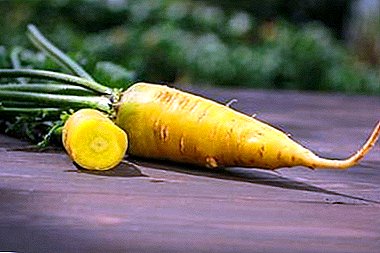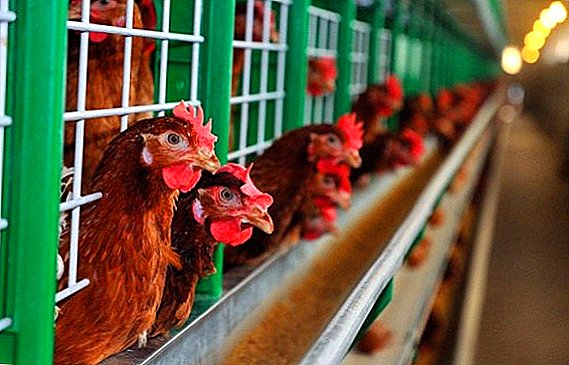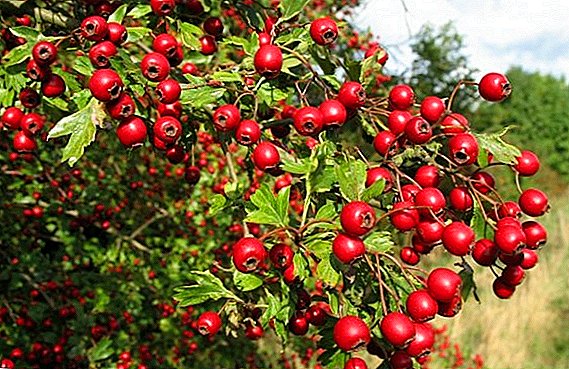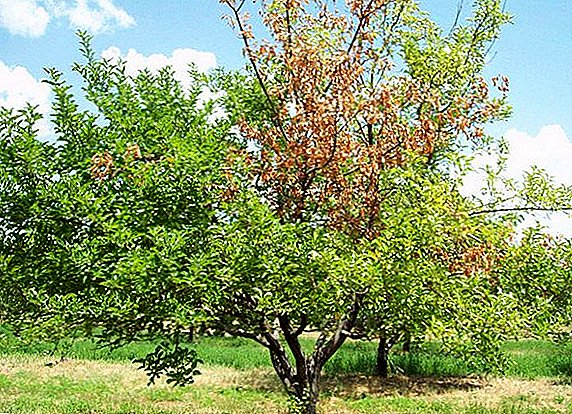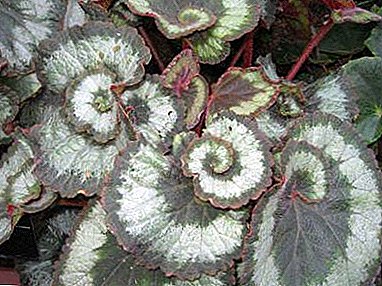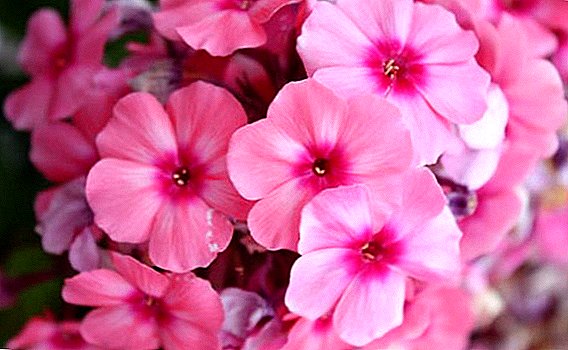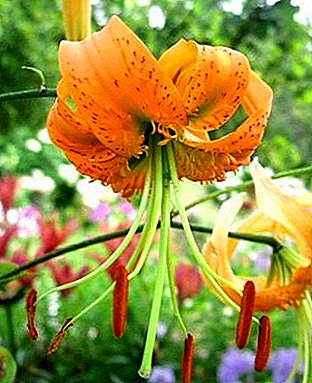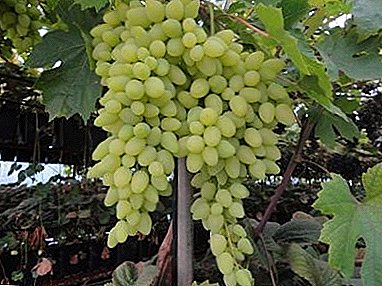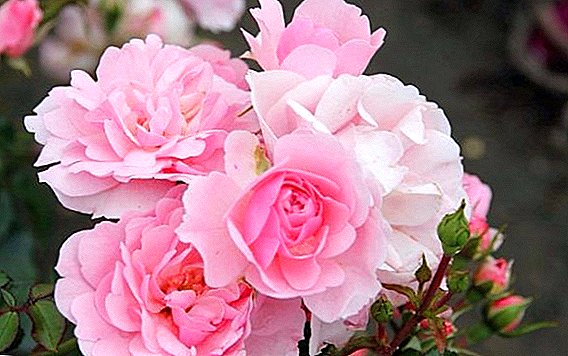 The pink rose "Bonika 82" received life in 1981 thanks to the breeder Meiyan and has since become the most common and used in the design of landscapes.
The pink rose "Bonika 82" received life in 1981 thanks to the breeder Meiyan and has since become the most common and used in the design of landscapes.
She won such attention due to its rapid growth, as well as long and abundant flowering.
Rose description
If you use several words to describe a plant, you can say: "Bonika" - Amazing unpretentious rose, which does not affect diseases and pests. But for her this is not enough, so consider the photos and characteristics of a flower that has won world fame. 
- The bush is large, very sprawling, reaches a height of 2 meters - it depends on the climatic conditions where it is planted. Looks great after spring pruning, when the branches are reduced by half the length.
- On the brushes of rich pink buds (there can be up to 15 pieces on one brush) pink flowers are revealed in diameter up to 8 centimeters each, which in hot weather fade to white. The flower is shaped like a bowl, with wavy petals. Flowers are used for cutting, they stand in vases for a long time.
- The period of flowering "Bonika" is very long - from the beginning of summer until late autumn it will tirelessly delight you with its flowers. But the most abundant and long flowering - the first.
- Dried flowers must be cut, as they produce many fruits of bright red color, which remain on the plant until spring. This feature is used in landscape design.
- The leaves on sturdy shoots are leathery, have a rich green color with a slight reddish tint at the base.
- Depending on the spring pruning, you can form a plant as a ground cover or shrub.
- The rose is frost-resistant, for shelter for the winter the lower part of the bush is buried.
- In the landscape can be used in group plantings, as a scrub, in individual planting and even in containers - as mobile flower beds.

Did you know? In 1982, in Germany, for its abundant flowering and good resistance to fungal diseases, the variety “Bonika 82” was awarded a German quality mark - ADR. In 2003, the flower was brought into the hall of fame of the World Federation of the Rose Rose Society, as "the world's favorite rose."
Choosing a landing site
Bonica roses are characterized by good endurance, a long flowering period, and it is quite cold-resistant. These key features must be considered when choosing a landing site.
Lighting and location
For long and vigorous flowering the plant needs sunlight. The rose will bloom in the penumbra, but it will not be as long and in such large numbers as in the sun. Also "Boniku" must be planted in ventilated places without air stagnation.
Important! Planting this variety in places with air stagnation and, consequently, with high humidity leads to the formation of black spots on the leaves, which in turn affects the decorativeness of the plant.
Soil selection
Since the rose is a perennial, and its root system penetrates deep into the ground, therefore, the preparation of the soil for planting should be thorough - at least one month before planting.  The main thing:
The main thing:
- that the soil was light, had low acidity;
- the fertile layer must be at least 60 centimeters;
- ideal soil for planting roses are loam;
- if there is a lot of clay in the ground, it is necessary to add sand, which makes the soil more light and breathable;
- a clayey substrate must be added to the sandy soil;
- marshy land is generally not suitable for planting roses. By changing its composition by adding sand, clay, lime and turf, you can also plant and grow good rose bushes.
We advise you to read about the cultivation and varieties of roses David Austin ("Falstaff", "Sins Thomas", "Abraham Derby", "Mary Rose", "William Shakespeare").
Correct fit
The development and ornamental appearance of the plant depends on how and how the seedling will be planted.
Selection of seedlings
The beauty of the rose bush depends on the quality of the planting material. A healthy plant does not require much effort in the care.  Saplings can be purchased in various forms:
Saplings can be purchased in various forms:
- Roots naked - such planting material is acquired during planting - in the fall or spring. If the seedling belongs to the highest category, then it has three stems, while the middle category has two stems. The diameter of the root of the neck to 10 centimeters. Roots should be healthy and well developed, packed in wet sawdust.
- The roots are packed in soil, wrapped in paper or wrapped in plastic so that they do not dry out.
- Bushes in containers - you can plant at any time. This is the most reliable option, since you can evaluate the shape and color of the flower. When planting the surface of the earthy coma and landing pit should be the same.
Read also about the peculiarities of cultivation of ground-covering, climbing and standard roses.
Landing pattern
Pale pink rose bushes are fine planted both in groups and alone, and the distance between plantings is important for their further development. It depends on the estimated size of the future bush. If the planting is too thick - there is a risk of a fungal disease, rare - the earth overheats by the sun, and weeds grow. Planting roses groups is carried out according to the scheme 70h95 centimeters, and if the bushes are planted in rows, then maintain a distance of 65 centimeters between them.  When planting you need to adhere to a specific scheme:
When planting you need to adhere to a specific scheme:
- A couple of days before planting, dig a hole 60x60x60 centimeters, fill it with water so that the earth is well soaked. The size of the planting pit depends on the root system of the seedling - they must be located freely, without kinks.
- Prepare the soil for planting. To do this, mix the soil with compost and peat in equal proportions, and then add ready-made fertilizer for roses, which is sold in garden stores.
- Pour a layer of drainage, and on top of the prepared soil lay out a mound. If the ground is sandy - drainage is not needed.
- The seedling with open roots is well inspected, cut off the damaged roots, cut long, leaving a length of no more than 30 centimeters. If the plant is in a container, carefully remove it from the ground so that the roots are not damaged. Leave no more than 3 strong shoots and shorten them so that there are no more than 3 good buds on the stem.
- Prepared bush down into the hole on a mound, spread out the roots and cover with earth. At the same time, the soil should be tamped gently, and at the same time the bush should be pulled up so that there are no voids left. Form an earthen roller for watering.
- Planted seedlings well shed water to the roots soaked with moisture, and filled the remaining voids.
Important! The rose is planted according to the rules when the vaccination site is under the ground at a depth of 5 centimeters. If seedlings are obtained from cuttings without a vaccine, you can plant more deeply to further form roots.
Caring for "Bonica"
If you have chosen the right place for planting, you have prepared the ground for the rose well - then the care of the variety “Bonik 82” consists in watering and timely fertilizing with fertilizers. 
Watering
Roses are moisture-loving, and they need good watering.
Read also about the varieties of roses: "Grand Gala", "Abracadabra", "Kerio", "New Dawn", "Chopin", "Blue Perfume", "Double Delight", "Pink Intuishn", "Sophia Loren", "Pierre de Ronsard, Jubilee Prince de Monaco, Gloria Dey, a group of Cordes and park roses.
But the need for water depends on the growth phase:
- the period of blooming buds, leaves, as well as the time after the first flowering of the plants most need abundant watering, because at this time are feeding, and water is a conductor of nutrients in the ground. It must settle and have an ambient temperature. Watering should be once a week in the amount of two 10-liter buckets under a bush. If the weather is dry, the operation should be done 2 times a week. Water should be carefully poured under a bush, not falling on the leaves. In order for the moisture to completely go under the plant, when opening the roses from the winter shelter, you need to create an earthen rampart around the bush, then the moisture will not flow to the sides. The best time to fill the plant with water is in the morning, up to 10 hours;
- in September, in rainy weather, it is not necessary to water the plants, so as not to stimulate the growth of young shoots. If autumn is dry, watering is necessary once a week - pour up to 5 liters of water under a bush;
- Before the winter shelter you need to make up to three buckets of water under one plant.
Important! After each watering, it is necessary to loosen the soil under a bush so that an earth crust does not form, closing the access of oxygen to the roots. Instead of loosening, you can use soil mulching under bushes with the help of organic matter.

Top dressing
For ornamental appearance and good development, plants need balanced nutrients, and they must receive them on time.
As dressings use:
- organic fertilizers — manure, chicken manure, ready-made compost — are added to the ground in the fall. It takes time to process them, and in the spring the bushes after winter awakening will begin to receive nutrients. The second organic dressing is carried out when the roses bloom;
- mineral fertilizers are a full complex, they are nourished by plants for 3 months, they are introduced in spring in early April, when bushes start growing. At the end of summer, it is necessary to feed the roses with potash fertilizers for the aging of the shoots and a good wintering.
We advise you to read about the features of the cultivation of tea, Dutch, Canadian roses.
Trimming features
"Bonike", like all roses, after the removal of the winter shelter necessary sanitary pruning. Removed dried, broken off and growing inside the bush branches. Depending on what decorative goals are pursued - such pruning is done. Since the rose "Bonika" refers to the flowering group of Floribunda, the old branches are definitely cut, and the young ones are cut to one third of the length. 
Protection against diseases and pests
"Bonika" is resistant to diseases and pests. By the end of summer or in the rainy summer season black spots may appear on the foliage. They do not interfere with flowering, but spoil the appearance. If the spots appear, then the foliage must be torn off and immediately burned, so that the spotting does not begin to spread to other plants. Also, to combat this problem, you must constantly remove the thin branches that thicken the bushes. Around the roses in the soil it is necessary to add wood ash for the prevention of diseases. The main pest "Boniki" - aphid. The bush must be shed with water under pressure and treated with a solution of liquid soap and alcohol.
Did you know? If you plant lavender bushes next to a rose of this variety, there will be not only an interesting combination of color, but also fragrant grass will scare away aphids.
Having learned all about the variety "Bonika 82", you can plant this wonderful rose on the plot, and with proper care, an unpretentious beauty will delight you with its bloom all season.


